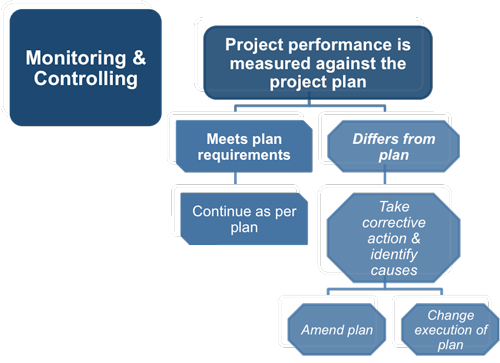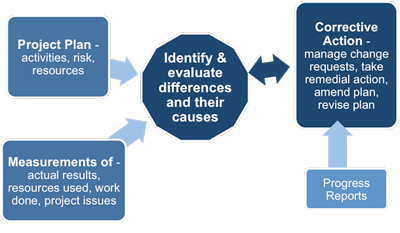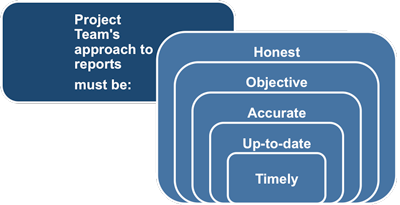Project Monitoring and Controlling Processes
The results of the executing processes are compared against the plan and where differences exist, corrective action is taken either to change the plan itself or the way in which the plan is being executed.
 |
The point of the exercise is to take account of what is being learned from the execution of the plan and to re-plan on the basis of this new information, in order to prevent future project work from becoming too detached from the plan.
Evaluation and comparison of actual measured results against those planned is the fundamental principle of this process group. Where there is a variance corrective action is required to keep the project on schedule and to budget. The inputs are the project plan and progress reports that contain data collected from the project team. Where progress deviates significantly, and this usually means outside of a predetermined tolerance limit, it is important to identify the underlying causes and take corrective action.
 |
Reporting mechanisms are time-sensitive and you will need to be able to take appropriate action as and when deviations occur. If the reporting mechanisms are slow then you will not be able to control the project; you will just have an historical account of how out of control it was.
The control framework will vary from project to project, reflecting the size and complexity of the project and the extent to which the different levels of management are involved in it. Short projects subject to a high degree of change and uncertainty will require shorter reporting cycles than projects of a longer duration that are relatively stable.
Collecting Performance Data
The best control systems are often the simplest and making the data collection processes complex only increases both the costs and possibility of error. The accuracy and timeliness of the data collection procedures will also be influenced by a series of practical issues and the overall attitude of project management staff.
 |
A practical issue that needs to be addressed is how the executing activities will be monitored and how progress will be reported. Project team members are usually expected to maintain up-to-date time sheets and records of the activities they are involved with. Their team leader then collates the data and passes it to the project manager.
The quality of this performance data is absolutely critical to the success of the project. Many projects run into trouble because reported progress does not match what is actually happening and the project manager acting on this information is unaware that problems are quietly stacking up. Project team members tend to develop a positive or negative attitude towards the value and importance of data collection quite early on in the project depending on how it is acted on by management.
Ideally the data that is collected should be as objective as possible and measure deliverables that have been completed or signed-off in some way. The worst approach is to ask people how much progress they have made on a task in percentage terms. Many people are naturally optimistic and want to be seen as a productive team member, which leads to persistent over-reporting of the progress they have made. This problem is made worse when management respond in a negative way to reported overruns.
You do not want team members attempting to disguise how much (or how little) progress they have made because if they do then the whole monitoring and control process will be a waste of time. You must do everything possible to collect objective data in a non-judgmental way.
You may also be interested in:
Project Management Processes | Project Initiation Processes | Project Planning Processes | Project Executing Processes | Project Monitoring and Controlling Processes | Project Change Control Processes | Project Closure Processes.
|
|


